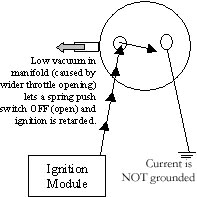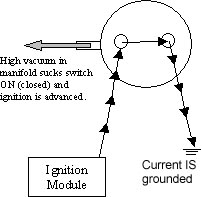Your VOES, and How to Wire a Telltale Light to Tell You What It's Doing

your VOES without the indicator light.
The left picture is ungrounded, which RETARDS the ignition.
The right picture is grounded, which ADVANCES the ignition.

|
If you came here from within wildwestcycle.com this is a new window. When done
reading, just close this one and you'll be back where you left from.
If you came here from outside wildwestcycle.com and would like to see more of the site, you'll find a link at the bottom of this article. |
|
Your VOES, and How to Wire a Telltale Light to Tell You What It's Doing |
||

|
These are the two operational states for your VOES without the indicator light. The left picture is ungrounded, which RETARDS the ignition. The right picture is grounded, which ADVANCES the ignition. |

|
|
Low
vacuum in manifold results from throttle plate being open, letting air into the
manifold. Low vacuum is an indicator of
a situation that may result in detonation if the load on the engine is high,
such as during acceleration or having the throttle open to go up a hill or into
a headwind. This situation can result
in ping or detonation. High
vacuum in the manifold results from throttle plate being (relatively)
closed. The pistons are sucking against
a closed door, so to speak. High vacuum
is usually present when the load on the engine is light, such as at steady
cruise on the level. Because the load is light, the danger of detonation is low and the ignition can be advanced more.
The VOES tells the ignition module that it's okay to put in a few degrees more advance than what the normal map calls for. When you have been cruising on the level the ignition carries that extra advance, but when you start up a hill (or around a truck, or whatever) and roll
the throttle open the vacuum drops, the VOES opens and signals the module to take out that extra advance to inhibit detonation.
The setting of the VOES spring is what controls how much vacuum (or open throttle) there has
to be before the ignition retards. If the spring is set too light the ignition retards too soon and you lose power.
Too heavy, and it doesnít retard soon enough and you may induce detonation when you open the throttle under a heavy load, such
as accelerating a heavy bike or going up a mountain pass.
There are no in-between states. The switch is either open or closed, and the ignition is either advanced that extra bit, or retarded. On a Crane Hi4 system the
difference is about four degrees. Remember, that is in addition to the usual RPM-induced advance curve. Knowing when your VOES is cycling from one mode into another is a good thing, especially if your engine is no longer stock. While the VOES should be tested at every tuneup, that doesnít let you know if it has failed
during the interim or if it is cycling when it should. A little light on the dash can give you that information. This diagram shows how to install a 12 volt LED in the VOES circuit. |
|
Hereís how the light works. ∑ When the VOES is open (Switch OFF-low vacuum) the voltage seeks ground through the LED, lighting it up. The LED, though, does not pass enough current to let the ignition module see that it is grounded, so it does not switch over to the advanced ignition curve, it stays retarded.* ∑ When the VOES is closed (Switch ON-high vacuum) all the juice goes through the VOES, which tells the ignition module that the circuit is grounded, so the module invokes the advanced curve. There is not enough current "left over" to light the LED, so it stays off.
Just remember: Light ON = RETARDED. Light OFF = ADVANCED (and if you're cruising and it's OFF, it should go ON when you open the throttle to get more power.) |
|
|
|
|
*CAUTION You MUST test this set up before trusting your engine to it.
This procedure has not been tested with all possible LEDs, nor with any incandescent or fluorescent bulbs. It may be that some of them WILL pass enough current to ground the advance circuit
in the black box, which would mean that your ignition is always advanced no matter what the VOES is doing. I use only a 12v LED from Radio Shack, Catalog #: 276-272. This comes with a housing and an orange lens; the emitted light from the LED is actually yellow. LED TECH TRIVIA THAT MATTERS: The color that an LED emits reflect the voltage drop that the LED induces in the juice flowing through it, with red being the lowest voltage drop (around 1.7vDC for normal-brightness LED) and white being way up the scale, as much as 5 volts. This matters when it comes to choosing an LED for the purpose described here. (Now, put your feet up, stare off into the distance, and ask yourself, "Why does it matter?" Well, I'll tell you. Take notes, now; there will be a test later.)
The reason is that the switch from advance to retard and back is controlled by the voltage drop that the ignition module "sees" as the VOES goes open and closed. And we don't know how much of a voltage drop it takes to do that. I know from experience that the Radio Shack LED referred to above, which gives about a 2vDC drop will not trigger the change. And that means, neither will a lesser voltage drop, and a red LED induces less drop, so that would be safe, too. But I have no idea what effect a green or a white LED would have, and since I already have something I like, I'm not going to experiment. You can, though, if you want. Tell me what you find out. Why didn't I use a red LED? Two reasons. Orange is more visible in bright light, and second, when I see a red light on the dash I want to know it means TROUBLE, like no oil pressure, not some lesser syndrome. Use your own judgment.
What all this adds up to is this: I say again: You MUST test the setup once you've done it.
Do this with the bike on the stand with the engine running in neutral at 2,500RPM or above. At that RPM level, because there is no load, the VOES will be ON, the timing will be fully advanced, and the LED will be OFF.
Now, with the RPM still at 2,500 or above, give the throttle a good, quick full-throttle blip, quick, but enough to run it up a thousand RPM or so. The vacuum in the manifold will drop as the throttle plate opens, the VOES will switch OFF, and the ground through it will no longer exist. The current will then seek ground through the LED, which will come ON. If you hold the RPMs for a second the LED will probably go OFF as the vacuum builds again and the VOES kicks in again, but you do want to see the light at least blink at you. Do this several times and watch for the result; the light comes ON when you blip the throttle. Once you're satisfied, hit the road.
Keep this in mind, though. Stuff fails. You'll soon have a sense of what it takes to trip the switch either way. If you notice a significant change in a well - established pattern of response, look into what's going on. |
|
As always at the end of one of these tips, a warning from Pilgrim. If you donít understand this material very clearly, forget it. Do it wrong and you can induce detonation, melt your pistons, drop a valve, ruin your heads, and all manner of bad shit. So, once more: DONíT TRY IT IF YOU ARE CONFUSED BY THE INSTRUCTIONS! |
|
TOP |
If you came here from outside Wild West Cycle
and want to see more of the site, click HERE. If you came here from within Wild West Cycle just close this window and you'll be back there. |